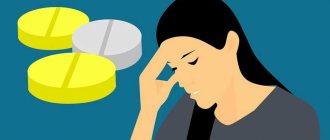Vegetative-vascular dystonia is not a diagnosis, but a syndrome that occurs for many reasons and has various manifestations. VSD is not included in ICD 10 and has no code. VSD of the hypertonic, hypotonic and mixed type is considered a syndrome of a number of diseases that affect the autonomic nervous system. The code range varies from G90 to G99. Vegetovascular dystonia is part of somatoform degenerative dysfunction, which has code F45.3 in ICD 10. The diagnosis of VSD is made only in Russia and other countries of the post-Soviet space. Foreign doctors do not accept him.
According to the nature of the course, there are permanent, paroxysmal, latent and mixed forms of VSD. The diagnosis of “VSD of mixed type” is made by doctors at the Yusupov Hospital after excluding the organic nature of autonomic dysfunction.
Why does vegetative-vascular dystonia (VSD) develop?
VSD is a pathological condition caused by increased excitability of the central nervous system (CNS). The fundamental factors in the occurrence of symptoms of autonomic dysfunction syndrome include hereditary disorders of the structure and functions of the nervous system and psychotraumatic factors, such as:
- chronic fatigue;
- stress, emotional overload;
- mental and physical stress;
- weather sensitivity.
However, symptoms of VSD can also be caused by the following reasons:
- previous neurological, endocrine and somatic diseases;
- allergy;
- abnormalities of body structure;
- unfavorable environmental conditions;
- climatic and meteorological conditions;
- physical inactivity;
- physiological hormonal changes;
- unbalanced diet and other factors.
Age-related characteristics play an important role in the occurrence of symptoms of VSD. Thus, in adolescence, the cause of unpleasant sensations is the uneven pace of development of individual organs and the parts of the autonomic nervous system that innervate them.
Thus, the symptoms of autonomic dysfunction are caused by changes in the activity of the sympathetic and parasympathetic systems. This, in turn, leads to excessive production of a number of biologically active substances and hormonal imbalance.
How can the disease be effectively treated?
The principles according to which it is necessary to treat VSD of the hypotonic type:
Etiotropic therapy: treatment of foci of chronic infection, hormonal disorders, elimination of the influence of harmful occupational factors and intoxications; eliminating bad habits (smoking, drinking alcohol).- Increase physical activity.
- Balanced diet.
- Normalization of sleep and rest patterns.
- Reducing body weight if it is excessive.
- Limit salt and saturated fat intake from meals.
If the above measures do not eliminate the symptomatic manifestations, doctors resort to prescribing medications :
- Drug treatment: sedative therapy - herbal medicine (valerian, hawthorn, St. John's wort, wormwood, peppermint, dog nettle); tranquilizers (Diazepam, Phenazepam, Mebicar, Phenibut, Oksidin, Amizil). If recommended by a psychotherapist, antidepressants.
- If necessary: adaptogens (ginseng, eleutherococcus), B vitamins, nootropics (nootropil, piracetam), drugs with metabolic effects (trimetazidine, mildronate).
- Reflexology: acupuncture, magnetic reflexotherapy.
- Physiotherapeutic procedures aimed at activating the sympathetic nervous system: paraffin, ozokerite, pine and salt baths, contrast shower.
- Active massage at a fast pace.
Types of vegetative-vascular dystonia
Depending on which autonomic disorder predominates, VSD is conventionally divided into the following types:
- cardiac
– cardiac disorders; - hypotonic
– a functional disorder characterized by a decrease in blood pressure and a weakening of vascular tone; - hypertensive
– a syndrome manifested by high blood pressure; - vagotonic
– an autonomic disorder associated with disruption of the vagus nerve; - mixed
- combining two or more of the listed types.
Prevention of autonomic dystonia syndrome
Strengthening health and restorative measures is the most important stage in the prevention of SVD. It is important not only to monitor the child and his lifestyle, but also to maintain a good microclimate in the family (reduce stress, prevent conflicts, and so on). Proper nutrition should be combined with adequate physical activity that is feasible for the child’s body. For preventive purposes, walks in the forest, drinking mineral waters, swimming in the sea, and clean mountain air are useful.
Symptoms of vegetative-vascular dystonia
The main symptoms of VSD depend on the functional state of the central and peripheral nervous systems, as well as the nature of autonomic disorders.
When VSD occurs with a disorder of the cardiovascular system, bursting, stabbing or aching pain appears in the heart area, an acceleration or deceleration of the heart rate, extrasystole (untimely contraction of the heart or its individual chambers), arrhythmia, and increased sweating are observed.
The list of symptoms of hypotonic VSD includes pallor of the skin, decreased blood pressure, weakness, chills, a feeling of lack of air, shallow breathing, and disruption of the digestive tract.
In disorders of the hypertensive type, the following manifestations of VSD are observed: frequent headaches, increased anxiety, an inexplicable feeling of fear, loss of appetite, nausea, impaired coordination of movements, a feeling of a veil or flashing spots before the eyes, excessive sweating.
People suffering from vagotonia experience decreased performance, increased fatigue and anxiety, apathy, sleep disturbances, and a tendency to develop depression. In addition, unpleasant sensations such as constant dizziness, causeless abdominal pain, night pain in the legs, intolerance to heat and cold, frequent urge to urinate, increased salivation, and constipation may occur.
Mixed type autonomic dysfunction is the most common form of VSD and is accompanied by signs characteristic of a variety of types of vegetative-vascular disorders. However, there are also specific symptoms of VSD that are unique to this condition: phobias, panic attacks, unreasonable fear of death, shortness of breath syndrome, chest pain, heart rhythm disturbances, drowsiness.
Due to the wide variety of manifestations of VSD, when choosing treatment tactics, specialists first of all pay attention to well-being and analyze complaints that make it possible to clarify the nature of the autonomic disorder.
Drugs for relief of vegetative-vascular crisis
Crises with VSD most often occur at a specific time of day for each patient. During these hours, the greatest shifts in autonomic reactivity are observed. Provoking factors may be weather changes, significant physical and emotional stress. Therefore, during a mixed-type VSD crisis, antidepressants, antipsychotics and other sedatives should be available to the patient. The drugs of choice for a short period are benzodiazepines (Grandaxin, diazepam, tranxene, medazepam, alprazolam) in combination with herbal sedative drugs (Persen, novopassit).
Doctors at the Yusupov Hospital teach patients how to stop a crisis on their own. To do this, in most cases, it is enough to take 1-2 tablets of diazepam under the tongue, sometimes in combination with 20-40 mg of anaprilin and 20 drops of Corvalol or Valocordin. A crisis that can be easily controlled by taking antipsychotics can form in the patient a kind of dependence on pills, give rise to suspicions of the presence of a “serious disease” and thereby contribute to the transition of the disease to the chronic stage, increasing the cyclicity of attacks.
Taking into account the difficulties in treating patients suffering from VSD and oversaturation with medications, rehabilitation therapists use reflexology, including laser puncture and laser therapy, and other non-drug treatment methods. In order to establish the true cause of VSD, undergo a course of adequate therapy aimed at stopping attacks and preventing exacerbation of vegetative-vascular dystonia, call the Yusupov Hospital.
Treatment of vegetative-vascular dystonia
Treatment of VSD is carried out in a complex, including drug therapy. Today, an effective drug that can act directly on the cause of vegetative-vascular disorders is Eltacin® .
This modern drug from the group of biological antioxidants contains three amino acids (glycine, glutamic acid and cystine). By interacting, they promote the production of glutathione. This compound, which is key in the body's antioxidant defense, normalizes the redox balance and improves the functional state of the autonomic nervous system.
Diagnosis of autonomic dystonia syndrome
In the diagnosis of the disease, an important place is occupied by symptoms, namely their development and course. Against this background, special importance is given to the collection of complaints and anamnesis. Next, the doctor examines the patient, monitors blood pressure, takes pharmacological and physical samples, studies the heart rate, and makes a thorough assessment of vegetative indices. To make a 100% correct diagnosis, additional procedures may be needed, such as cardiointervalography or electrocardiography. After the above studies, Doppler ultrasound of the vessels of the brain, neck and heart is usually performed.
Causes
The list of causes of neurocirculatory dystonia is extensive. It includes:
- hormonal changes: puberty, pregnancy, menopause;
- acute and chronic stress;
- physical or mental fatigue;
- lack of sleep;
- bad habits: smoking, alcohol abuse;
- poor nutrition and excess body weight;
- change of climate and time zones;
- hereditary predisposition;
- drinking large amounts of coffee, energy drinks, and certain medications;
- infectious diseases;
- pathology of the endocrine glands;
- mental disorders;
- osteochondrosis of the cervical spine;
- chronic pathology of the gastrointestinal tract, kidneys, digestive or cardiovascular systems.
Make an appointment
Vegetative-vascular dystonia ( VSD
) is a complex of various clinical symptoms, which “in general” is characterized by disturbances in the functioning of the human autonomic nervous system. The autonomic nervous system is responsible for the coordinated functioning of internal organs, exocrine and endocrine glands, blood and lymphatic vessels, and is responsible for such important body functions as: breathing, circulation, digestion, metabolism, excretion, reproduction and growth functions.
Vegetative-vascular dystonia has several synonyms: autonomic dysfunction, autonomic dystonia, neurocirculatory dystonia (NCD).
Vegetative-vascular dystonia is not an independent disease, but a set of clinical symptoms that are the result of disturbances in the functioning of certain systems or organs of the human body. Or a set of clinical symptoms that go hand in hand with certain diseases or syndromes. For example, such as: cardiac neurosis, angioneurosis, panic attack, functional cardiopathy, vasomotor dystonia, psychovegetative syndrome, neurotic disorders and others.
Since everything in the human body is interconnected, disturbances in the functioning of a particular organ or system affect the functioning of other organs and systems. For example, disturbances in the functioning of the cardiovascular system of the human body lead to a failure of the mechanism for the full supply of oxygen to the organs and tissues of the body, as well as a failure of the mechanism for the timely removal of carbon dioxide, waste substances and toxins from the organs and tissues, which, in turn, causes various malfunctions and disturbances in the functioning of the whole organism “as a whole”.
AUTONOMIC NERVOUS SYSTEM
For a more complete understanding of what vegetative-vascular dystonia is, it is necessary to consider the principles of operation of the autonomic nervous system.
The autonomic nervous system (or visceral nervous system) is the autonomous part of the nervous system, i.e. a person cannot consciously influence its work. For example, a person cannot, of his own free will and desire, control and change the functioning of internal organs, external and internal secretion glands (heart, liver, kidneys, spleen, etc.).
The autonomic nervous system regulates and controls the coordinated work of all internal organs, the work of lymphatic and blood vessels, the glands of external and internal secretions, and also performs the function of maintaining balance in the internal environment of the body and its activities.
The “unconscious” control of the autonomic nervous system is responsible for more than 80% of vital functions in the human body. Many processes occur in the body without our direct participation, for example, breathing and heartbeat, digestion, the functioning of the immune system and others. After all, we cannot make our heart beat less often or faster, we don’t think about the fact that we need to breathe, all these processes are controlled by the unconscious part of our brain.
That is, in other words: the activity of the autonomic nervous system is not subject to the control of human consciousness and human will.
The autonomic nervous system regulates many physiological processes and biochemical processes occurring in the body: maintains normal levels of blood pressure, body temperature, is responsible for metabolic processes, urination, digestion, controls heart rate, respiration, controls the activity of the cardiac and vascular systems, immune and endocrine systems, sweating. It also mobilizes the body’s systems to adapt to changing environmental conditions.
The autonomic nervous system is usually divided into its constituent parts: metasympathetic, sympathetic and parasympathetic parts.
The metasympathetic nervous system is responsible for the functioning of internal organs that have contractility (heart, stomach and digestive tract, bladder, etc.).
The sympathetic nervous system is more responsible for daytime wakefulness, mental activity, stress, and physical activity. On the contrary, the parasympathetic nervous system is more responsible for resting the body, restoring strength, and sleeping. These two systems seem to alternate with each other, and this allows the body to expend strength during the day and fully recover at night. For the body to function properly, there must be a balance between these two systems. An imbalance or equilibrium between the sympathetic and parasympathetic systems leads to the occurrence of vegetative-vascular dystonia.
SYMPTOMS OF VEGETIC-VASCULAR DYSTONIA
Vegetative-vascular dystonia can have a variety of symptoms, which are expressed in disruptions in the functioning of various body systems:
- cardiovascular system
: fluctuations in venous and blood pressure from hypertension (high blood pressure) to hypotension (low blood pressure), impaired blood circulation in tissues; pain in the left side of the chest, pain in the heart area, abnormal heart rate, tachycardia (rapid heartbeat), sensation of heart stopping. - respiratory system
: rapid breathing, shortness of breath, feeling of lack of air, difficulty or conversely rapid breathing, inability to take a deep breath or unexpected deep breaths. - gastrointestinal system
: abdominal pain, nausea, vomiting, constipation, belching, heartburn, diarrhea (diarrhea), flatulence. - genitourinary system
: painful and frequent urination, pain and itching in the genital area; sexual disorders and dysfunctions are possible, among the many manifestations of which may be: lack of sexual desire or erection, lack of orgasm with normal sexual desire, and others. - thermoregulatory system
: causeless fluctuations in body temperature, increased sweating, chills, cold or heat waves. - vestibular system
: dizziness, unsteadiness, lightheadedness, tremors in the legs and others. - mental and neurological manifestations, often combined with emotional disorders
: decreased performance, increased fatigue, internal tension, weakness, lethargy, heightened sensitivity to weather changes (meteosensitivity), dizziness, headaches, sleep disturbances and shuddering during sleep, decreased appetite, irritability , sudden mood swings, tearfulness, causeless feelings of anxiety and restlessness, various fears.
CAUSES OF VEGETIC-VASCULAR DYSTONIA
Psychological aspect
The occurrence of vegetative-vascular dystonia, according to statistics, is one of the most common and significant for consideration, because each person has unique characteristics and psychological characteristics, and because of this, stress, chronic fatigue, overwork, overwork, and neuroses are a common cause of the disease. Very often, people who experience constant stress experience overstrain (overload) of the body. This leads to exhaustion of the body, as well as to a decrease in the adaptive and protective capabilities of the body. First of all, this affects regulatory systems and leads to disruption of the regulation and proper functioning of blood vessels and internal organs.
Also, an equally significant aspect of the occurrence of vegetative-vascular dystonia is diseases of the spine
or various problems with it (for example, displacement of the vertebrae). Thus, quite often one has to deal with the fact that disturbances in the functioning of internal organs, pain in them, impaired sensitivity of the limbs, headaches, weather sensitivity and other manifestations are the result of a certain disease of the spine, which results in pinching (compression) of the spinal nerve root (or several roots at the same time). The consequence of such infringement of the nerve root is a violation of innervation (control of the functioning of tissues and organs with the help of nerves), pain, disruption of the functioning of the organ that is controlled through the affected nerve.
Factors under the influence of which vegetative-vascular dystonia develops:
- excessive physical, emotional and mental stress, irregular sleep, overwork;
- stress, emotional stress, neurosis and other neurotic disorders;
- diseases of the spine (osteochondrosis, often cervical osteochondrosis, radiculitis and others), as well as various problems with the spine;
- hereditary predisposition, congenital disorders of the nervous system, physical inactivity acquired in childhood;
- hormonal changes in the body during periods: puberty, menopause, pregnancy, after taking contraceptive and hormonal drugs;
- climate change;
- previous intoxications and various infectious diseases, decreased immunity;
- exacerbation of endocrine diseases (thyroid gland, gonads, adrenal glands, thyrotoxicosis, diabetes mellitus);
- brain damage (various injuries, strokes, tumors);
- smoking in large quantities;
- frequent consumption of alcoholic beverages.
TYPES OF VEGETIC-VASCULAR DYSTONIA
It is customary to distinguish three types of vegetative-vascular dystonia. The classification depends on the level of blood pressure and a number of clinical symptoms:
- hypertensive type
(characterized by high blood pressure). - hypotonic type
(characterized by low blood pressure). - mixed type
(characterized by periodic fluctuations in blood pressure).
All types of vegetative-vascular dystonia are characterized by vegetative-vascular crises
, significantly worsening a person’s performance and general well-being.
For hypertensive type
There is increased blood pressure, rapid heartbeat, sudden agitation, chills, cold extremities, and symptoms of a panic attack.
With hypotonic type
low blood pressure, cardiac arrest, shortness of breath, sweating, nausea, and general weakness are observed.
For mixed type
The possibility of spontaneous manifestation of both of the above symptoms is characteristic; they can be combined or present simultaneously.
The formation of crises is based on an excessive concentration of biologically active substances in the body, such as acetylcholine, norepinephrine, adrenaline, etc., as well as the heightened sensitivity of the receptors of the endocrine and nervous systems to these substances. A crisis can be provoked and activated by disturbances in rhythm and lifestyle, changes in climatic zones and climate change, intoxication, physical and emotional overload.
RISK GROUPS FOR VEGETIC-VASCULAR DYSTONIA
Vegetative-vascular dystonia is one of the most common diseases and is diagnosed in approximately 80% of the population aged 45 - 50 years. Men and women are equally susceptible to the disease. It is worth noting that there is a hereditary predisposition to this disease.
The first manifestations of vegetative-vascular dystonia can be observed already in childhood or adolescence. The disease that occurs at this age becomes an unfavorable background for the development of a number of other diseases. The main symptoms are: feeling of weakness, headache, absent-mindedness, intracranial pressure, constant fatigue, elevated body temperature, lack of appetite, moodiness. Many parents begin to completely protect their child from sports, swimming, and prolonged exposure to the air. All this can lead to even greater weakening of the child in the future.
More pronounced disorders often appear between the ages of 20 and 30 and are characterized by headaches, ringing and tinnitus, dizziness, tachycardia, irritability, insomnia and other manifestations.
In adulthood, vegetative-vascular dystonia is often accompanied by many other diseases, such as spinal diseases, endocrine diseases, mental disorders, often chronic.
PREVENTION OF VEGETIC-VASCULAR DYSTONIA
A number of the aspects listed below will significantly help in preventing the disease, normalizing the body’s activity and restoring psychological balance.
- Full sleep.
Harmonization of work and rest. The duration of sleep should be at least 8 - 9 hours a day. It is better not to exhaust your body with chronic lack of sleep, as this can affect the nervous system, aggravate existing disorders and provoke the occurrence of many ailments. Alternate physical, mental and emotional stress with proper rest and relaxation psychological relief (yoga classes, auto-training, walks in nature, relaxing massage). It is necessary to take short breaks during the day while working, especially if it is working on a computer or physically difficult work. Sanatorium-resort treatment is quite effective. - Healthy eating.
You should avoid overeating, especially at night. You should eat often, but in small portions, eat a variety of foods (fish, meat, dairy products, vegetables, fruits). The most useful and best absorbed by the body are products from the geographical area in which you live and where your ancestors lived (for example, for residents of Ukraine, apples are much healthier than exotic mangoes or pineapples). - Rejection of bad habits.
It is necessary to give up or limit yourself as much as possible from bad habits (smoking, alcohol and others). - Physical activity.
An active lifestyle, as well as walks in the fresh air, have a beneficial effect on all aspects of the human body, in particular for its psychological and emotional balance. Daily exercise, gymnastics, physical education, swimming, fitness, walks in the fresh air and more positive emotions are beneficial.
TREATMENT OF VEGETIC-VASCULAR DYSTONIA
The treatment tactics for vegetative-vascular dystonia are complex treatment using non-surgical methods.
Treatment of vegetative-vascular dystonia is aimed at achieving the following objectives:
- eliminate the cause of the disease;
- stop further development of the disease;
- eliminate the existing consequences of the disease.
The timing of treatment and its results directly depend on the stage of development of the disease, and therefore it is extremely important to diagnose the disease as early as possible.
With timely treatment, the patient’s life changes qualitatively: pain symptoms of the disease disappear (or are significantly weakened), the functioning of vital systems and organs is normalized, the body’s adaptive functions are restored, energy tone is restored, appetite and sleep are normalized, sudden mood swings stop, etc. .
Our medical center has been treating vegetative-vascular dystonia since 2003.
An individual treatment program (course) is developed for each patient based on the type of dystonia, stage of the disease, gender, age, temperament of the patient and other factors.
Treatment course for vegetative-vascular dystonia
in our center consists of 10 - 15 complex treatment sessions. Frequency of visits: daily or every other day. The duration of each complex treatment session is about 1 hour.
Treatment sessions include manual therapy (according to indications), relaxation massage, therapeutic massage, magnetic laser therapy, electromyostimulation, drug therapy and others.
The desire and attitude of the patient play a significant role in achieving positive treatment results in a short time!
Treatment at the Energy of Health clinic
Doctors at the Energy of Health clinic do not downplay the significance of the symptoms of NCD. We guarantee each patient a thorough examination, including all the necessary samples and tests, as well as selection of the most gentle, but at the same time effective treatment. At your service:
- drawing up a medication correction regimen in accordance with the characteristics of the course of the disease (not only the complex of symptoms, form and stage of the disease are taken into account, but also the emotional background, chronic diseases, hormonal status, characteristics of the patient’s work, etc.);
- restorative procedures: physiotherapy, massage;
- selection of physical exercises to perform in the gym with an instructor and at home;
- acupuncture;
- help from a psychotherapist and psychiatrist;
- selection of a resort for treatment in a sanatorium, collection of necessary documents;
- detailed recommendations for correcting lifestyle, nutrition, and physical activity.
We will help keep the disease under control and will always come to the rescue in case of exacerbation.









